-
Posts
790 -
Joined
-
Last visited
Content Type
Profiles
Uncrowned Armory News
Prepping Cookbook
Conspiracy Theories
Uncrowned Tactical Sports News
Prepping
Forums
Events
Everything posted by Uncrowned Guard
-

Su-57's Build Quality at Zhuhai Air Show Sparks Debate
Uncrowned Guard posted an article in Defense Industry
Concerns Raised Over Su-57’s Construction at Zhuhai Air Show In an unexpected turn of events, the recent display of the Sukhoi Su-57 at the forthcoming Zhuhai air show has raised eyebrows over its perceived subpar construction quality. A close examination of a widely circulated video raises questions about the overall build of Russia's prospective stealth fighter. Insight into the Su-57 at Zhuhai The aircraft set to grace the air show—the model 054 prototype—has been showcased at various air shows, particularly in its Russian homeland. According to the 2024 World Air Forces directory by FlightGlobal, the Russian Air Force includes 14 such aircraft in its fleet and has placed orders for another 62. The video that brought this issue to light, predominantly shared via Chinese social media, examines the front left part of the aircraft, including the fuselage joint and the leading edge of the left wing. It abruptly comes to an end as a result of intervention by security personnel. https://x.com/clashreport/status/1853403110657409363 Noteworthy Observations and Public Reactions Some noticeable irregularities include seemingly rough fuselage joints and uneven rivets uncharacteristic of modern stealth fighters, and panels that do not align seamlessly forming prominent gaps. Similar flaws can be traced back to former Russian aircraft designs. Also discernible were the aircraft’s infrared search and track sensor and two pitot tubes located just beneath the forward canopy. The Su-57's leading edge extension (LEE) and leading edge have visibly poorly fitted joints. The LEE's position, bent sharply downward, exposes large holes, necessary for attaching the actuator. Additionally, the wing's underside panels are not flush. These apparent flaws in stealth features have subjected the Su-57 to mockery on Chinese social media platforms, with an unfavorable comparison being drawn to the Chengdu J-20. Questionable Security Measures and Combat Effectiveness Alarmingly, the security measures surrounding the aircraft, touted as a cutting-edge, fifth-generation stealth fighter, were glaringly inadequate. Photographers managed to get exceptionally close to the jet, noting that the intakes – vital for creating a truly low visibility aircraft – were unshielded. The Lockheed Martin F-35's security, in contrast, is notably stringent at air shows and press interactions, with photo opportunities restricted to a safe distance and the fighter's intakes and thrust nozzles fitted with covers. Despite its status as Russia's most advanced fighter, the Su-57’s contributions to Russia's Ukraine incursion have been minimal. The UK Defence Intelligence revealed in January 2023 that, despite being deployed against Ukraine, the Su-57 has only struck from stand-off ranges, suggesting Moscow's anxiety over the potential downing of the aircraft over Ukrainian territory. Further adding to its dilemmas, a Su-57 was reportedly damaged by a Ukrainian drone strike at a distant airbase this year. The Zhuhai Air Show Roster and Media Exclusion The 2024 Zhuhai air show, scheduled from November 12th to 17th, will also feature China's new Shenyang J-35, capable of landing on an aircraft carrier, and the J-20. However, there is speculation that a myriad of unmanned systems won't be on display. Notably, this year's show is not welcoming international media—a stark difference from previous years, when the event attracted global media—since both mainstream and trade outlet reporters have been denied invitations.-
- su-57
- zhuhai air show
- (and 3 more)
-
Hyundai Introduces Silent Stealth Battle Tank Fueled by Hydrogen Due to Hyundai subsidiary Rotem, South Korea is poised to be the first country to design and introduce entirely hydrogen fuel cell-operated battle tanks. Rotem recently revealed its envisionment of the future of core battle machinery for the Republic of Korea (ROK) - tanks driven by hydrogen energy. Transition from Diesel to Hydrogen Power in Battle Tanks ROK's K-series battle tanks will transition into the next version, K3, powered by hydrogen and equipped with state-of-the-art technology, making it one of the most technologically advanced tanks globally. The K3 tank, designed in partnership with the Korean Agency for Defense Development and other national technology research institutions, anticipates hitting the production line by 2040, catapulting it to be the first of its kind in the world. This innovative tank will substitute the diesel engine of the K-series with hydrogen fuel cells. This project plans a phased transition, with initial prototypes fusing hydrogen and diesel engines. This development aligns with South Korea's broader vision of shifting its war machinery away from combustible engines. Hyundai Rotem - Revolutionary Main Battle Tanks "The next-generation main battle tanks surpass all capabilities of current MBTs, providing a more effective mission implementation with advanced technology for future warfare. Hyundai Rotem is gearing for future warfare by designing next-generation main battle tanks that enhance combatant capabilities and functional replacements. Our priority is peacekeeping," The company explains on its official website. Modernized Attributes of K3 The new version, K3, will flaunt enhanced stealth competencies, autonomous driving, slave drones, and a new 130-mm smoothbore main gun. An official at Hyundai Rotem stated, "Using an artificial intelligence-based control system, the next-generation tank will have a superior pre-emptive strike ability." Making military assets like tanks more sustainability extends beyond itself - it also provides comprehensive improvements that render the new tank highly flexible and fatal on the battlefield. These include low heat discharge due to the absence of hot exhaust, significantly reduced noise levels during mobility, enhanced acceleration, and much better fuel economy. Additionally, with fewer moving components, the tank is also expected to require less maintenance and maneuver more efficiently across steep and rough terrains. The K3 will be manned by a three-man crew - a driver, a commander, and a gunner housed inside an intensively armored capsule towards the front of the hull. Robust Defense and Increased Firepower This design seeks to enhance crew protection by shielding them from potential threats from autoloaders and ammunition storage. The tank is well-armed with an unmanned turret having a remotely controlled 130 mm smoothbore cannon, enabling targeting from up to 3 miles (5 kilometers) off. The K3 will also feature sophisticated armor comprising an inventive mix of modular steel, ceramic, and composites. Moreover, the tanks will come equipped with multi-purpose anti-tank guided missiles (ATGMs) capable of reaching up to 5 miles (8 kilometers), including advanced modes for both line-of-sight and beyond-line-of-sight engagements. There will also be a remote-controlled weapon station on the turret that can accommodate weapons ranging between 12.7mm to 30mm. The tank will leverage advanced defensive technologies, such as a Directional Infrared Countermeasures (DIRCM) system to thwart heat-seeking missiles, an Active Protection System (APS), and a drone jamming device. Its low-profile design, combined with reduced radar and infrared signatures, makes it extremely challenging to detect on the battlefield, akin to the Polish PL-01 tank. View full article
-
- hyundai rotem
- hydrogen fuel cell
- (and 3 more)
-
Hyundai Introduces Silent Stealth Battle Tank Fueled by Hydrogen Due to Hyundai subsidiary Rotem, South Korea is poised to be the first country to design and introduce entirely hydrogen fuel cell-operated battle tanks. Rotem recently revealed its envisionment of the future of core battle machinery for the Republic of Korea (ROK) - tanks driven by hydrogen energy. Transition from Diesel to Hydrogen Power in Battle Tanks ROK's K-series battle tanks will transition into the next version, K3, powered by hydrogen and equipped with state-of-the-art technology, making it one of the most technologically advanced tanks globally. The K3 tank, designed in partnership with the Korean Agency for Defense Development and other national technology research institutions, anticipates hitting the production line by 2040, catapulting it to be the first of its kind in the world. This innovative tank will substitute the diesel engine of the K-series with hydrogen fuel cells. This project plans a phased transition, with initial prototypes fusing hydrogen and diesel engines. This development aligns with South Korea's broader vision of shifting its war machinery away from combustible engines. Hyundai Rotem - Revolutionary Main Battle Tanks "The next-generation main battle tanks surpass all capabilities of current MBTs, providing a more effective mission implementation with advanced technology for future warfare. Hyundai Rotem is gearing for future warfare by designing next-generation main battle tanks that enhance combatant capabilities and functional replacements. Our priority is peacekeeping," The company explains on its official website. Modernized Attributes of K3 The new version, K3, will flaunt enhanced stealth competencies, autonomous driving, slave drones, and a new 130-mm smoothbore main gun. An official at Hyundai Rotem stated, "Using an artificial intelligence-based control system, the next-generation tank will have a superior pre-emptive strike ability." Making military assets like tanks more sustainability extends beyond itself - it also provides comprehensive improvements that render the new tank highly flexible and fatal on the battlefield. These include low heat discharge due to the absence of hot exhaust, significantly reduced noise levels during mobility, enhanced acceleration, and much better fuel economy. Additionally, with fewer moving components, the tank is also expected to require less maintenance and maneuver more efficiently across steep and rough terrains. The K3 will be manned by a three-man crew - a driver, a commander, and a gunner housed inside an intensively armored capsule towards the front of the hull. Robust Defense and Increased Firepower This design seeks to enhance crew protection by shielding them from potential threats from autoloaders and ammunition storage. The tank is well-armed with an unmanned turret having a remotely controlled 130 mm smoothbore cannon, enabling targeting from up to 3 miles (5 kilometers) off. The K3 will also feature sophisticated armor comprising an inventive mix of modular steel, ceramic, and composites. Moreover, the tanks will come equipped with multi-purpose anti-tank guided missiles (ATGMs) capable of reaching up to 5 miles (8 kilometers), including advanced modes for both line-of-sight and beyond-line-of-sight engagements. There will also be a remote-controlled weapon station on the turret that can accommodate weapons ranging between 12.7mm to 30mm. The tank will leverage advanced defensive technologies, such as a Directional Infrared Countermeasures (DIRCM) system to thwart heat-seeking missiles, an Active Protection System (APS), and a drone jamming device. Its low-profile design, combined with reduced radar and infrared signatures, makes it extremely challenging to detect on the battlefield, akin to the Polish PL-01 tank.
-
- hyundai rotem
- hydrogen fuel cell
- (and 3 more)
-
Northrop Grumman Introduces Aerial Data Center to Boost Military Intelligence Northrop Grumman, the renowned defense contractor, has released new technology destined to supersede traditional methods of intelligence gathering for military operations. The technology, informally known as a flying data center, transforms an aircraft into a hub for real-time processing of data garnered from satellites, drones, and sensors on land and at sea. Deep Sensing and Targeting: A Game-changer for Real-time Intelligence Branded as the Deep Sensing and Targeting system (DSAT), this latest innovation saw its debut at a U.S. Army exercise last month. Brent Swift, the director of the DSAT program situated in Northrop Grumman's intelligence center in Colorado, declared, "We're supplying immediate, space-based intelligence to the airborne platform, making it accessible to operators." Swift asserts that this technology holds the potential to address long-standing hindrances faced by the military regarding precise and timely targeting data. Such information is essential during rapid combat situations to guide long-range artillery and missile strikes. The live demonstration was conducted during the Vanguard 24 exercise at Fort Huachuca, Arizona. This two-week event was aimed at piloting advanced military sensors and surveillance systems. Overcoming the Shortcomings of Ground-based Stations The DSAT manifested its capability to process different forms of intelligence data while aboard a commercial aircraft during this demo. The collected data was primarily from both commercial and military satellites and transmitted via tactical radios, enabling communication with units within and outside the direct line of sight. This novel approach effectively bypasses the limitations posed by traditional stationary ground stations, which often lose connection with satellites due to physical obstructions or distance. An Evolution in Military Intelligence Infrastructure Swift acknowledged the Army's current investment in ground-based systems like the Tactical Intelligence Targeting Access Node (TITAN) built by Palantir Technologies. He added that Northrop Grumman's airborne system builds upon a former TITAN prototype developed by the company in 2022. In addition, as part of the Army's plan to modernize its intelligence tools, the Sierra Nevada Corp. scored a billion-dollar contract for creating HADES (High Accuracy Detection and Exploitation System), a highly specialized intelligence aircraft. This deal is now under scrutiny as rival defense contractor L3Harris Technologies has lodged a dispute. View full article
-
- northrop grumman
- military intelligence
- (and 3 more)
-
Northrop Grumman Introduces Aerial Data Center to Boost Military Intelligence Northrop Grumman, the renowned defense contractor, has released new technology destined to supersede traditional methods of intelligence gathering for military operations. The technology, informally known as a flying data center, transforms an aircraft into a hub for real-time processing of data garnered from satellites, drones, and sensors on land and at sea. Deep Sensing and Targeting: A Game-changer for Real-time Intelligence Branded as the Deep Sensing and Targeting system (DSAT), this latest innovation saw its debut at a U.S. Army exercise last month. Brent Swift, the director of the DSAT program situated in Northrop Grumman's intelligence center in Colorado, declared, "We're supplying immediate, space-based intelligence to the airborne platform, making it accessible to operators." Swift asserts that this technology holds the potential to address long-standing hindrances faced by the military regarding precise and timely targeting data. Such information is essential during rapid combat situations to guide long-range artillery and missile strikes. The live demonstration was conducted during the Vanguard 24 exercise at Fort Huachuca, Arizona. This two-week event was aimed at piloting advanced military sensors and surveillance systems. Overcoming the Shortcomings of Ground-based Stations The DSAT manifested its capability to process different forms of intelligence data while aboard a commercial aircraft during this demo. The collected data was primarily from both commercial and military satellites and transmitted via tactical radios, enabling communication with units within and outside the direct line of sight. This novel approach effectively bypasses the limitations posed by traditional stationary ground stations, which often lose connection with satellites due to physical obstructions or distance. An Evolution in Military Intelligence Infrastructure Swift acknowledged the Army's current investment in ground-based systems like the Tactical Intelligence Targeting Access Node (TITAN) built by Palantir Technologies. He added that Northrop Grumman's airborne system builds upon a former TITAN prototype developed by the company in 2022. In addition, as part of the Army's plan to modernize its intelligence tools, the Sierra Nevada Corp. scored a billion-dollar contract for creating HADES (High Accuracy Detection and Exploitation System), a highly specialized intelligence aircraft. This deal is now under scrutiny as rival defense contractor L3Harris Technologies has lodged a dispute.
-
- northrop grumman
- military intelligence
- (and 3 more)
-
Imminent Arrival of Mirage 2000 Jets Enhances Ukraine's Defence Arsenal In a pivotal move to bolster Ukraine's defense capability, France is set to deliver Mirage 2000 aircraft to the Eastern European nation in the forthcoming months. This revelation was made by French Foreign Minister Jean-Noël Barrot during a recent press conference he held jointly with his Ukrainian counterpart, Foreign Minister Andrii Sybiha. The first of these aircraft is anticipated to touch Ukrainian soil in the early months of 2025. French Support Bolsters Ukraine’s Defense Sector Further emphasizing France's undeterred commitment to Ukraine, Barrot cited concrete instances of this alliance. He shed light on France's initiative to bolster Ukraine's defense prowess by providing military hardware and training programs. As a pioneer, France stands as the first nation to have fully trained a Ukrainian brigade, aptly named the Anna Kyivska brigade. An important inclusion in this support is the delivery of the first Mirage 2000 aircraft, slated for early next year. Enhanced Operational Capability through Pilot Training Beyond providing state-of-the-art combat machinery, France is also assuming the responsibility of training Ukrainian pilots to skillfully navigate the newly acquired aircraft, thereby enhancing the operational capacity within the Ukrainian Air Force. Enriching Ukraine’s Military Aircraft Fleet with Western-style Jets Reports dating back to June suggested a strategic augment of Ukraine's combat aircraft fleet by the end of 2024. The new additions were predicted to consist of Western-style aircraft, including F-16 fighters and ACS 890 long-range reconnaissance aircraft from the United States, along with the Mirage 2000-5 from France. The French government has charted plans to supply Ukraine with an arsenal of 20 Mirage 2000-5F fighters. The original delivery dates have since been revised, and supplies are now expected to commence in the first quarter of 2025. Additionally, there have been hints at a potential upgrading of the Mirage-2000 jets to be delivered to Ukraine. View full article
-
- ukraine defense
- mirage 2000 jets
- (and 3 more)
-
Imminent Arrival of Mirage 2000 Jets Enhances Ukraine's Defence Arsenal In a pivotal move to bolster Ukraine's defense capability, France is set to deliver Mirage 2000 aircraft to the Eastern European nation in the forthcoming months. This revelation was made by French Foreign Minister Jean-Noël Barrot during a recent press conference he held jointly with his Ukrainian counterpart, Foreign Minister Andrii Sybiha. The first of these aircraft is anticipated to touch Ukrainian soil in the early months of 2025. French Support Bolsters Ukraine’s Defense Sector Further emphasizing France's undeterred commitment to Ukraine, Barrot cited concrete instances of this alliance. He shed light on France's initiative to bolster Ukraine's defense prowess by providing military hardware and training programs. As a pioneer, France stands as the first nation to have fully trained a Ukrainian brigade, aptly named the Anna Kyivska brigade. An important inclusion in this support is the delivery of the first Mirage 2000 aircraft, slated for early next year. Enhanced Operational Capability through Pilot Training Beyond providing state-of-the-art combat machinery, France is also assuming the responsibility of training Ukrainian pilots to skillfully navigate the newly acquired aircraft, thereby enhancing the operational capacity within the Ukrainian Air Force. Enriching Ukraine’s Military Aircraft Fleet with Western-style Jets Reports dating back to June suggested a strategic augment of Ukraine's combat aircraft fleet by the end of 2024. The new additions were predicted to consist of Western-style aircraft, including F-16 fighters and ACS 890 long-range reconnaissance aircraft from the United States, along with the Mirage 2000-5 from France. The French government has charted plans to supply Ukraine with an arsenal of 20 Mirage 2000-5F fighters. The original delivery dates have since been revised, and supplies are now expected to commence in the first quarter of 2025. Additionally, there have been hints at a potential upgrading of the Mirage-2000 jets to be delivered to Ukraine.
-
- ukraine defense
- mirage 2000 jets
- (and 3 more)
-
A New Approach to Battle Command Systems: Stryker and UGV 'Wingmen' The modern battlefield is about to take on a new look thanks to an ambitious concept spearheaded by General Dynamics Land Systems (GDLS). This innovative strategy centers on command-and-control operations evolving to become more nimble, highly protected, and versatile. Crucial to realizing this concept is the Mission Command On The Move (MCOTM) Stryker, an initiative reimagining how command systems could be managed on the battlefield. Forward-thinking Tech Unveiled at AUSA At the recent Association of the United States Army (AUSA) conference, GDLS introduced the MCOTM concept, which combines advanced command center technologies with a team adept at interpreting critical data for fast and effective decisions. The strategy behind this design is packing all these capabilities into a highly mobile armored vehicle that can be relocated close to the battle's frontlines, protected by a cohort of Uncrewed Ground Vehicles (UGVs), also under its control. This idea aims to improve the agility, survivability, and protection of command control nodes in a modern combat environment. The concept evolves from fixed command centers, recognizing their vulnerability to precision-guided missiles and drone technology. By enabling rapid repositioning of these centers, MCOTM provides an authenticated solution to significant logistical challenges in setting up, dismantling, and moving traditional command centers. Fostering an Armored Ecosystem of Manned-Unmanned Teaming Of equal importance is the ability of this mobile command control node to leverage a variety of UGVs for defensive and offensive operations. With a networked, armored, high-mobility C2 node, there is potential for greater proximity to some of the UGVs it controls, enabling direct line-of-sight connectivity. The vehicles, in turn, offer direct fire, reconnaissance, air defense, and additional transport capabilities, forming an armored ecosystem that is the direction the Army intends to pursue. Central to implementing this concept is the 8×8 MCOTM armored vehicle, based on the StrykerX demonstrator. The new Stryker MCOTM, unveiled as a step towards the development of this concept, optimizes space to accommodate seven soldiers and uses GDLS's KATALYST Next Generation Electronic Architecture (NGEA). The system integrates all of its components, allowing rapid adaptability to changing tactical realities and technologies, and also reduces electromagnetic signatures. The hybrid propulsion too contributes to these efforts. Unmanned Support on the Battlefield The Stryker MCOTM is accompanied by the newly revealed iteration of GDLS's 8×8 Multi-Utility Tactical Transport (MUTT) robotic vehicle, MUTT XM, and the latest TRX Defender, a modular robotic vehicle configurable to provide combined ground and air defense fire support. The MUTT XM, specifically optimized for toughness against electromagnetic interference, serves as an equipment-carrying 'robotic mule,' with the potential for various combat, combat support, and combat service support functions. To enhance the ability of the command vehicle in terms of self-protection, the setup also includes an Iron Fist Light active protection system. Designed for neutralizing incoming threats, including anti-tank guided missiles and other infantry anti-armor weapons, this installation can potentially shield against incoming drones and drone-launched projectiles in the near future. Conclusion: The Future Military Landscape As the US Army looks to upend the conventional battle landscape by integrating UGVs into its armored units, GDLS's concept offers a feasible solution. Encouraging the controlled proximity of the controller vehicle to the drones can help circumvent deficiencies in autonomy besides fostering situational awareness. Being the central C2 node or 'quarterback' for drones, even by maintaining some functionalities, could change modern warfare dynamics. Even if the described system is not adopted, the idea of such configurations will likely shape future military technology. View full article
-
- battlefield technology
- unmanned ground vehicles
- (and 3 more)
-
A New Approach to Battle Command Systems: Stryker and UGV 'Wingmen' The modern battlefield is about to take on a new look thanks to an ambitious concept spearheaded by General Dynamics Land Systems (GDLS). This innovative strategy centers on command-and-control operations evolving to become more nimble, highly protected, and versatile. Crucial to realizing this concept is the Mission Command On The Move (MCOTM) Stryker, an initiative reimagining how command systems could be managed on the battlefield. Forward-thinking Tech Unveiled at AUSA At the recent Association of the United States Army (AUSA) conference, GDLS introduced the MCOTM concept, which combines advanced command center technologies with a team adept at interpreting critical data for fast and effective decisions. The strategy behind this design is packing all these capabilities into a highly mobile armored vehicle that can be relocated close to the battle's frontlines, protected by a cohort of Uncrewed Ground Vehicles (UGVs), also under its control. This idea aims to improve the agility, survivability, and protection of command control nodes in a modern combat environment. The concept evolves from fixed command centers, recognizing their vulnerability to precision-guided missiles and drone technology. By enabling rapid repositioning of these centers, MCOTM provides an authenticated solution to significant logistical challenges in setting up, dismantling, and moving traditional command centers. Fostering an Armored Ecosystem of Manned-Unmanned Teaming Of equal importance is the ability of this mobile command control node to leverage a variety of UGVs for defensive and offensive operations. With a networked, armored, high-mobility C2 node, there is potential for greater proximity to some of the UGVs it controls, enabling direct line-of-sight connectivity. The vehicles, in turn, offer direct fire, reconnaissance, air defense, and additional transport capabilities, forming an armored ecosystem that is the direction the Army intends to pursue. Central to implementing this concept is the 8×8 MCOTM armored vehicle, based on the StrykerX demonstrator. The new Stryker MCOTM, unveiled as a step towards the development of this concept, optimizes space to accommodate seven soldiers and uses GDLS's KATALYST Next Generation Electronic Architecture (NGEA). The system integrates all of its components, allowing rapid adaptability to changing tactical realities and technologies, and also reduces electromagnetic signatures. The hybrid propulsion too contributes to these efforts. Unmanned Support on the Battlefield The Stryker MCOTM is accompanied by the newly revealed iteration of GDLS's 8×8 Multi-Utility Tactical Transport (MUTT) robotic vehicle, MUTT XM, and the latest TRX Defender, a modular robotic vehicle configurable to provide combined ground and air defense fire support. The MUTT XM, specifically optimized for toughness against electromagnetic interference, serves as an equipment-carrying 'robotic mule,' with the potential for various combat, combat support, and combat service support functions. To enhance the ability of the command vehicle in terms of self-protection, the setup also includes an Iron Fist Light active protection system. Designed for neutralizing incoming threats, including anti-tank guided missiles and other infantry anti-armor weapons, this installation can potentially shield against incoming drones and drone-launched projectiles in the near future. Conclusion: The Future Military Landscape As the US Army looks to upend the conventional battle landscape by integrating UGVs into its armored units, GDLS's concept offers a feasible solution. Encouraging the controlled proximity of the controller vehicle to the drones can help circumvent deficiencies in autonomy besides fostering situational awareness. Being the central C2 node or 'quarterback' for drones, even by maintaining some functionalities, could change modern warfare dynamics. Even if the described system is not adopted, the idea of such configurations will likely shape future military technology.
-
- battlefield technology
- unmanned ground vehicles
- (and 3 more)
-
The Netherlands to Purchase 46 Leopard 2A8 Tanks and Boost Defense Capabilities Against Rising Threats In response to a surging Russian aggression, the Netherlands has announced its plans to reinstate its heavy armor capacity by procuring 46 Leopard 2A8 tanks from the French-German defense company, KNDS. This €1 billion (US$1.1 billion) purchase is a notable initiative towards fortifying military deterrents, only ten years after the country's last batch of tanks were sold to Finland. A Strategic Investment in Missile Defense Further strengthening their defense system, the Dutch government will also be acquiring four short-range and six medium-range air-defense batteries from Norway's Kongsberg, said Gijs Tuinman, the State Secretary for Defence. The value of this deal is expected to be approximately 11 billion Norwegian kroner ($1 billion), as confirmed in a separate statement by Kongsberg. The recent period has seen Dutch defense officials and military leaders stepping up their public presence to emphasize the necessity of intensified armed forces in the face of potential threats stemming from Russia's invasion of Ukraine. Following suit, the Netherlands announced its intention last month to reinstate a tank battalion, and augment its fleet with extra F-35 fighter jets and anti-submarine frigates, all supported by a growing defense budget. Reviving Heavy Armor and The Rising Influence of Unmanned Systems In a letter to the parliament, Tuinman illustrated the crucial role of battle tanks in modern conflict scenarios, as evident by the ongoing war in Ukraine. He emphasized the decision to reinstate a well-rounded tank battalion aligns with the priority objectives prescribed by NATO. However, alongside the initial purchase of 46 tanks, the Netherlands also anticipates investing in unmanned systems as a cost-effective alternative for six additional battle tanks. The function of these unmanned systems covers not only targeting enemy drones and armored vehicles but also comprises capabilities for surmounting hurdles and conducting reconnaissance. Tuinman pointed out that if technological advancements deem this feasible by 2027, the extra tanks might no longer be necessary for the goal of establishing a comprehensive tank battalion by 2030. Challenging Chronology and Further Developments The rapid acquisition of these battle tanks is needed to secure a privileged production slot, owing to a sudden spike in the demand for heavy weapon systems and the short supply of slots in the reactivated KNDS production lines. The Dutch government aims to finalize a deal with Germany by year-end. Any delay in contract finalization could potentially hamper the timeline, as several nations are vying for a place in the KNDS delivery schedule. The budget for the tank battalion, totaling between €1 billion and €2.5 billion, will cover spare parts, maintenance, operation costs, as well as support requirements such as transport, trucks, maintenance, supply, and recovery vehicles. The battalion and its support capacities will necessitate the involvement of around 500 military personnel. Regarding air defense, the Netherlands will be purchasing six medium-range and four short-range air-defense batteries from Kongsberg; alongside, orders for additional multi-mission radar systems from Thales will be placed. With a budget of €2.58 billion, the first delivery of these systems is projected to commence in 2028, and full operational capacity is expected by 2030. A Strategic Defense Overhaul Beyond tank procurement and preferences for unmanned systems, this defense reinforcement plan touches upon comprehensive national security undertakings, deeply affecting the incorporation of NASAMS (National Advanced Surface to Air Missile System), NOMADS (National Maneuver Air Defence System), and an Army Combat Support Vehicle G5. The strategic decision to engage in a foreign military sales agreement with the U.S ties in the AIM-120 AMRAAM-ER, AIM-120C8 AMRAAM missiles, and AIM-9X Sidewinder missiles, all compatible with the F-35 fighter jets of the Dutch forces. All of these considered, this strategic defense revamp aligns with the Dutch government's commitment to bolstering its national security in light of escalating geopolitical threats. View full article
-
- dutch defense investment
- leopard 2a8 tanks
- (and 3 more)
-
The Netherlands to Purchase 46 Leopard 2A8 Tanks and Boost Defense Capabilities Against Rising Threats In response to a surging Russian aggression, the Netherlands has announced its plans to reinstate its heavy armor capacity by procuring 46 Leopard 2A8 tanks from the French-German defense company, KNDS. This €1 billion (US$1.1 billion) purchase is a notable initiative towards fortifying military deterrents, only ten years after the country's last batch of tanks were sold to Finland. A Strategic Investment in Missile Defense Further strengthening their defense system, the Dutch government will also be acquiring four short-range and six medium-range air-defense batteries from Norway's Kongsberg, said Gijs Tuinman, the State Secretary for Defence. The value of this deal is expected to be approximately 11 billion Norwegian kroner ($1 billion), as confirmed in a separate statement by Kongsberg. The recent period has seen Dutch defense officials and military leaders stepping up their public presence to emphasize the necessity of intensified armed forces in the face of potential threats stemming from Russia's invasion of Ukraine. Following suit, the Netherlands announced its intention last month to reinstate a tank battalion, and augment its fleet with extra F-35 fighter jets and anti-submarine frigates, all supported by a growing defense budget. Reviving Heavy Armor and The Rising Influence of Unmanned Systems In a letter to the parliament, Tuinman illustrated the crucial role of battle tanks in modern conflict scenarios, as evident by the ongoing war in Ukraine. He emphasized the decision to reinstate a well-rounded tank battalion aligns with the priority objectives prescribed by NATO. However, alongside the initial purchase of 46 tanks, the Netherlands also anticipates investing in unmanned systems as a cost-effective alternative for six additional battle tanks. The function of these unmanned systems covers not only targeting enemy drones and armored vehicles but also comprises capabilities for surmounting hurdles and conducting reconnaissance. Tuinman pointed out that if technological advancements deem this feasible by 2027, the extra tanks might no longer be necessary for the goal of establishing a comprehensive tank battalion by 2030. Challenging Chronology and Further Developments The rapid acquisition of these battle tanks is needed to secure a privileged production slot, owing to a sudden spike in the demand for heavy weapon systems and the short supply of slots in the reactivated KNDS production lines. The Dutch government aims to finalize a deal with Germany by year-end. Any delay in contract finalization could potentially hamper the timeline, as several nations are vying for a place in the KNDS delivery schedule. The budget for the tank battalion, totaling between €1 billion and €2.5 billion, will cover spare parts, maintenance, operation costs, as well as support requirements such as transport, trucks, maintenance, supply, and recovery vehicles. The battalion and its support capacities will necessitate the involvement of around 500 military personnel. Regarding air defense, the Netherlands will be purchasing six medium-range and four short-range air-defense batteries from Kongsberg; alongside, orders for additional multi-mission radar systems from Thales will be placed. With a budget of €2.58 billion, the first delivery of these systems is projected to commence in 2028, and full operational capacity is expected by 2030. A Strategic Defense Overhaul Beyond tank procurement and preferences for unmanned systems, this defense reinforcement plan touches upon comprehensive national security undertakings, deeply affecting the incorporation of NASAMS (National Advanced Surface to Air Missile System), NOMADS (National Maneuver Air Defence System), and an Army Combat Support Vehicle G5. The strategic decision to engage in a foreign military sales agreement with the U.S ties in the AIM-120 AMRAAM-ER, AIM-120C8 AMRAAM missiles, and AIM-9X Sidewinder missiles, all compatible with the F-35 fighter jets of the Dutch forces. All of these considered, this strategic defense revamp aligns with the Dutch government's commitment to bolstering its national security in light of escalating geopolitical threats.
-
- dutch defense investment
- leopard 2a8 tanks
- (and 3 more)
-
Revamping the Bradley Infantry Fighting Vehicle: Two Teams Undertake Preliminary Design Reviews In the quest to replace the renowned Bradley Infantry Fighting Vehicle (IFV), key industrial teams have completed preliminary design evaluations, a major prerequisite ahead of the projected milestone for 2025. The announcement was made by Major General Glenn Dean, the Army Program Executive Officer for Ground Combat Systems. Two Industry Teams Selected for the Next Phase General Dynamics Land Systems and American Rheinmetall Vehicles were singled out from a group of competitors in June 2023 and will now proceed to a comprehensive design segment of the XM30 Mechanized Infantry Combat Vehicle project. These organizations are tasked with creating a hybrid fighting system equipped with a range of lethal capabilities. The planned vehicle design includes a 50 mm cannon, a remote turret, advanced machine guns, anti-tank guided missiles, an integrated protection suite, and intelligent fire control. Additionally, it will have third-generation infrared sensors, kitted armor, and signature management capabilities. The details were divulged by military authorities deeply involved in the project. Financial Implications and Future Expectations The dual contracts carry a collective worth of approximately $1.6 billion, but the total program is set to value around $45 billion, as outlined by the army. The final preliminary design review concluded in August, with the service expected to swiftly complete critical design reviews before commencing the construction of physical prototypes. Following the finalization of the design and acquisition of required materials, prototypes are expected to be built within 18 to 20 months post-completion of the critical design reviews. Subsequently, the army will advance to a test and evaluation stage with both competing teams, leading up to the selection of a winner in the fiscal year of 2027. The initial vehicles are anticipated to be deployed in the fiscal year of 2029. The Importance of Soldier Feedback in the Design Process The rapid timeline from preliminary to critical design reviews has been made viable by digital engineering methodologies and constant integrations with soldiers both virtually and physically. The process offers soldiers the opportunity to inspect proposed designs, providing valuable input to improve ergonomics and functionality based on real-world combat experience. Significant strides have been achieved, ranging from subtle user interface modifications to major alterations in the structural design. This feedback and integration process benefits both the vendors and the military, ensuring designs are optimized to meet the specific requirements of the end users. Partnering to Innovate The team led by American Rheinmetall Defense is inclusive of notable industry players such as Textron Systems, RTX, L3Harris Technologies, Allison Transmission, and artificial intelligence pioneer, Anduril Technologies. On the other hand, GDLS is collaborating with automotive autonomy specialists, Applied Intuition; GM Defense; and AeroVironment, a company contributing its Switchblade loitering munitions to the design. Furthermore, GDLS is incorporating network, radio, and cyber capabilities into the project in partnership with General Dynamics Mission Systems. View full article
-

Bradley IFV Replacement: Teams Gear Up for Next Design Phase
Uncrowned Guard posted an article in Defense Industry
Revamping the Bradley Infantry Fighting Vehicle: Two Teams Undertake Preliminary Design Reviews In the quest to replace the renowned Bradley Infantry Fighting Vehicle (IFV), key industrial teams have completed preliminary design evaluations, a major prerequisite ahead of the projected milestone for 2025. The announcement was made by Major General Glenn Dean, the Army Program Executive Officer for Ground Combat Systems. Two Industry Teams Selected for the Next Phase General Dynamics Land Systems and American Rheinmetall Vehicles were singled out from a group of competitors in June 2023 and will now proceed to a comprehensive design segment of the XM30 Mechanized Infantry Combat Vehicle project. These organizations are tasked with creating a hybrid fighting system equipped with a range of lethal capabilities. The planned vehicle design includes a 50 mm cannon, a remote turret, advanced machine guns, anti-tank guided missiles, an integrated protection suite, and intelligent fire control. Additionally, it will have third-generation infrared sensors, kitted armor, and signature management capabilities. The details were divulged by military authorities deeply involved in the project. Financial Implications and Future Expectations The dual contracts carry a collective worth of approximately $1.6 billion, but the total program is set to value around $45 billion, as outlined by the army. The final preliminary design review concluded in August, with the service expected to swiftly complete critical design reviews before commencing the construction of physical prototypes. Following the finalization of the design and acquisition of required materials, prototypes are expected to be built within 18 to 20 months post-completion of the critical design reviews. Subsequently, the army will advance to a test and evaluation stage with both competing teams, leading up to the selection of a winner in the fiscal year of 2027. The initial vehicles are anticipated to be deployed in the fiscal year of 2029. The Importance of Soldier Feedback in the Design Process The rapid timeline from preliminary to critical design reviews has been made viable by digital engineering methodologies and constant integrations with soldiers both virtually and physically. The process offers soldiers the opportunity to inspect proposed designs, providing valuable input to improve ergonomics and functionality based on real-world combat experience. Significant strides have been achieved, ranging from subtle user interface modifications to major alterations in the structural design. This feedback and integration process benefits both the vendors and the military, ensuring designs are optimized to meet the specific requirements of the end users. Partnering to Innovate The team led by American Rheinmetall Defense is inclusive of notable industry players such as Textron Systems, RTX, L3Harris Technologies, Allison Transmission, and artificial intelligence pioneer, Anduril Technologies. On the other hand, GDLS is collaborating with automotive autonomy specialists, Applied Intuition; GM Defense; and AeroVironment, a company contributing its Switchblade loitering munitions to the design. Furthermore, GDLS is incorporating network, radio, and cyber capabilities into the project in partnership with General Dynamics Mission Systems. -
Introducing the CC9: Heckler & Koch USA's Premier Firearm The American arm of Heckler & Koch, renewed and dynamic, is now catering to the US civilian market with its debut firearm - the CC9—a slim, compact concealed-carry pistol. The CC9 is distinctive, not solely because of its impressive feature set typical of such weaponry or its sleek design, but also due to its stringent and intensive pre-market testing phases. Rigorous Testing Standards The CC9 is the pride of HK USA, being its very first United States-designed and tested product. Even though it marks a new beginning, the product was subjected to H&K's renowned extensive testing processes. Alongside the conventional reliability tests for NATO small arms, a specific 'lint test' was devised to accommodate the concealed carry environment. Innovative Features for Updated Standards Aligned with modern expectations, the CC9 is equipped with features desirable in concealed carry pistols. It boasts an RMSc-footprint optics cut, full ambidexterity, and less than a one-inch width. Additionally, larger handgun character identifications, such as changeable backstraps and a Picatinny rail for light mounting, have been incorporated into this compact design. To give an edge in low-light conditions, the front sight includes a tritium lamp, while the rear sight is blacked out to minimize distraction. The CC9 package includes two magazines; a 10-round and a 12-round extended version. The serialized part is not the frame but a chassis inside it, hinting at the future prospects of modification. CC9 Specifications Fore Sight: Tritium-lit High Visibility Rear Sight: Serrated, Blacked-Out Barrel: Hammer Forged Canon Grade Steel Rifling: Polygonal, 6-groove, twist 1-10 Optics Compatibility: Shield RMSc Safety Features: Trigger, Firing Pin, Disassembly Add-ons: Soft Case, Manual, Child Safety Lock, Large Backstrap Magazine Sizes: 10+1 & 12+1 Suggested Retail Price: $699 Length: 6.03” Width: 0.99” Height (with 10-round magazine): 4.5” Barrel Length: 3.32” Trigger Pull: 5 lbs. Weight (without magazine): 18.4 oz. H&K USA's Statement On The New Pistol "With pride, Heckler & Koch, the internationally acclaimed small arms manufacturer, presents the CC9—a state-of-the-art, micro-compact, 9mm, striker-fired pistol. The meticulously crafted CC9 aptly demonstrates H&K’s commitment to precision engineering and craftsmanship. It effectively reshapes the landscape for micro-compact firearms with its sleek design and faultless functioning. The CC9 is suitable for all shooting skill levels and showcases superior performance and precision, be it at a shooting range or in defensive settings. Designed and manufactured exclusively in the US to cater to the US Concealed-Carry market, the CC9 is subject to the same stringent quality criteria as all other H&K firearms. The CC9 exemplifies reliability. It embodies Heckler & Koch’s signature precision and rigorous testing standards to meet NATO Army Armaments Group AC/225 standards. Emulating the conditions of real-world performance, the CC9 successfully withstood a battery of tests to examine its performance in extreme weather conditions and against dust, sand, and mud. It was also dropped from various heights to test its durability. During its developmental and testing stages, more than 750,000 rounds were fired through the CC9, reinforcing its suitability for enduring and performing under the most demanding conditions). Featuring a full-fledged +P chassis system, the CC9 emphasizes top-tier performance and handling similar to a full-sized firearm. It offers excellent accuracy and control while accommodating the user's preferences through its interchangeable backstrap system for personal customization. The CC9 ensures consistent, smooth trigger pulls, and its superior recoil management allows for rapid follow-up shots. It is optics-ready, with a tritium front sight and a blacked-out serrated rear sight, to aid quick target acquisition in high-stress situations." The CC9 redefines the concealed carry standard as the smallest double-stack pistol ever produced by HK. Packaged with a 10-round and 12-round magazine, its streamlined, lightweight design is as functional as it is aesthetically pleasing. With its mirror-image ambidextrous slide-stop and magazine release, the CC9 ensures unparalleled ease of carry without compromising capacity. The pistol encompasses multiple safety features, including a trigger safety, built-in 'Out-of-Battery' safety, passive firing pin safety, and a 'Safe Take Down Feature' that negates the need to pull the trigger during disassembly. Also incorporated is a visual and tactile loaded chamber indicator. Adapting to modern concealed carry needs, the CC9 is compatible with a wide range of accessories, including lights and lasers, via its integrated Picatinny-style accessory rail. Furthermore, the slide is equipped with an RMSc / 407k compatible mount for most modern micro-dot sights. HK is being duly recognized for its unfaltering commitment to quality and excellence with their first micro-compact pistol that meets their rigorous standards. Visit your local authorized HK dealer today to get your CC9.” View full article
-
- firearms
- concealed carry
-
(and 3 more)
Tagged with:
-
Introducing the CC9: Heckler & Koch USA's Premier Firearm The American arm of Heckler & Koch, renewed and dynamic, is now catering to the US civilian market with its debut firearm - the CC9—a slim, compact concealed-carry pistol. The CC9 is distinctive, not solely because of its impressive feature set typical of such weaponry or its sleek design, but also due to its stringent and intensive pre-market testing phases. Rigorous Testing Standards The CC9 is the pride of HK USA, being its very first United States-designed and tested product. Even though it marks a new beginning, the product was subjected to H&K's renowned extensive testing processes. Alongside the conventional reliability tests for NATO small arms, a specific 'lint test' was devised to accommodate the concealed carry environment. Innovative Features for Updated Standards Aligned with modern expectations, the CC9 is equipped with features desirable in concealed carry pistols. It boasts an RMSc-footprint optics cut, full ambidexterity, and less than a one-inch width. Additionally, larger handgun character identifications, such as changeable backstraps and a Picatinny rail for light mounting, have been incorporated into this compact design. To give an edge in low-light conditions, the front sight includes a tritium lamp, while the rear sight is blacked out to minimize distraction. The CC9 package includes two magazines; a 10-round and a 12-round extended version. The serialized part is not the frame but a chassis inside it, hinting at the future prospects of modification. CC9 Specifications Fore Sight: Tritium-lit High Visibility Rear Sight: Serrated, Blacked-Out Barrel: Hammer Forged Canon Grade Steel Rifling: Polygonal, 6-groove, twist 1-10 Optics Compatibility: Shield RMSc Safety Features: Trigger, Firing Pin, Disassembly Add-ons: Soft Case, Manual, Child Safety Lock, Large Backstrap Magazine Sizes: 10+1 & 12+1 Suggested Retail Price: $699 Length: 6.03” Width: 0.99” Height (with 10-round magazine): 4.5” Barrel Length: 3.32” Trigger Pull: 5 lbs. Weight (without magazine): 18.4 oz. H&K USA's Statement On The New Pistol "With pride, Heckler & Koch, the internationally acclaimed small arms manufacturer, presents the CC9—a state-of-the-art, micro-compact, 9mm, striker-fired pistol. The meticulously crafted CC9 aptly demonstrates H&K’s commitment to precision engineering and craftsmanship. It effectively reshapes the landscape for micro-compact firearms with its sleek design and faultless functioning. The CC9 is suitable for all shooting skill levels and showcases superior performance and precision, be it at a shooting range or in defensive settings. Designed and manufactured exclusively in the US to cater to the US Concealed-Carry market, the CC9 is subject to the same stringent quality criteria as all other H&K firearms. The CC9 exemplifies reliability. It embodies Heckler & Koch’s signature precision and rigorous testing standards to meet NATO Army Armaments Group AC/225 standards. Emulating the conditions of real-world performance, the CC9 successfully withstood a battery of tests to examine its performance in extreme weather conditions and against dust, sand, and mud. It was also dropped from various heights to test its durability. During its developmental and testing stages, more than 750,000 rounds were fired through the CC9, reinforcing its suitability for enduring and performing under the most demanding conditions). Featuring a full-fledged +P chassis system, the CC9 emphasizes top-tier performance and handling similar to a full-sized firearm. It offers excellent accuracy and control while accommodating the user's preferences through its interchangeable backstrap system for personal customization. The CC9 ensures consistent, smooth trigger pulls, and its superior recoil management allows for rapid follow-up shots. It is optics-ready, with a tritium front sight and a blacked-out serrated rear sight, to aid quick target acquisition in high-stress situations." The CC9 redefines the concealed carry standard as the smallest double-stack pistol ever produced by HK. Packaged with a 10-round and 12-round magazine, its streamlined, lightweight design is as functional as it is aesthetically pleasing. With its mirror-image ambidextrous slide-stop and magazine release, the CC9 ensures unparalleled ease of carry without compromising capacity. The pistol encompasses multiple safety features, including a trigger safety, built-in 'Out-of-Battery' safety, passive firing pin safety, and a 'Safe Take Down Feature' that negates the need to pull the trigger during disassembly. Also incorporated is a visual and tactile loaded chamber indicator. Adapting to modern concealed carry needs, the CC9 is compatible with a wide range of accessories, including lights and lasers, via its integrated Picatinny-style accessory rail. Furthermore, the slide is equipped with an RMSc / 407k compatible mount for most modern micro-dot sights. HK is being duly recognized for its unfaltering commitment to quality and excellence with their first micro-compact pistol that meets their rigorous standards. Visit your local authorized HK dealer today to get your CC9.”
-
- firearms
- concealed carry
-
(and 3 more)
Tagged with:
-
Australia to Boost Ukraine's Defense with 49 Abrams Tanks In an unprecedented turn of national security events, Australia has offered a massive boost to Ukraine's land defense forces. Converging in an agreement, Australia will transfer 49 M1A1 Abrams tanks to Ukraine, thereby enriching Kyiv's armored capabilities. This groundbreaking move brings an end to speculations about Australia's potential provision of vital armor to Ukraine. Unveiling of Australia's Defense Support The official announcement of the military assistance is due to be unveiled in Brussels by Pat Conroy, Minister for Defense Industry and Capability, at the NATO Defense Ministerial meetings. Valued at approximately $245 million AUD ($164 million USD), the tanks boost Australia’s defense aid to Ukraine to an impressive figure surpassing $1.3 billion. Conroy announced the transfer during a media briefing in London. In an official statement, Conroy affirmed that these tanks would enhance the firepower and mobility of the Ukrainian Armed Forces. He further highlighted how this equipment complements the support provided by other partners to Ukraine. Given the tanks were originally purchased from the United States, their transfer required official U.S. approval, a significant note that Conroy pointed out. Implications for Ukraine's War Effort Welcoming Australia's decision, Vasyl Myroshnychenko, Ukraine's Ambassador to Australia, lauded the new armor as a "significant contribution" to Ukraine's war effort in a dialogue with ABC. Referencing the tanks’ alignment with existing defense lines, the ambassador reaffirmed their functionality due to previous use by Ukrainian teams, highlighting their critical role in strengthening land defenses. Australian Government's Shift in Defense Strategy This latest equipment transfer follows a major policy shift by Prime Minister Anthony Albanese's government. Back in February, Defense Minister Richard Marles stated that they had no plans to supply Ukraine with these tanks. The government's move contrasts the previous criticism for not transferring prematurely retired Taipan helicopters to Ukraine. A certain percentage of the transferred tanks may require refurbishment or overhaul to some extent due to their near-end-of-life status. This decision, however, lies solely in Ukraine's hands. This transition is facilitated by the Australian Army's recent acquisition of its first-ever fleet of 75 M1A2 tanks, which enabled the transfer timing. Decoding the Effectiveness of Abrams in Ukraine The adequacy of the Abrams tanks in Ukraine has been under scrutiny. As reported by the Associated Press earlier this year, Ukraine had to withdraw its American-supplied M1A1s from the front lines due to their vulnerability to Russian weapons. However, Ukraine's decision to equip the M1s with reactive armor and jammers has ostensibly improved protection. View full article
-
- australia-ukraine defense
- abrams tanks transfer
- (and 3 more)
-

Australia Enhances Ukraine's Defense with 49 Abrams Tanks Boost
Uncrowned Guard posted an article in Military News
Australia to Boost Ukraine's Defense with 49 Abrams Tanks In an unprecedented turn of national security events, Australia has offered a massive boost to Ukraine's land defense forces. Converging in an agreement, Australia will transfer 49 M1A1 Abrams tanks to Ukraine, thereby enriching Kyiv's armored capabilities. This groundbreaking move brings an end to speculations about Australia's potential provision of vital armor to Ukraine. Unveiling of Australia's Defense Support The official announcement of the military assistance is due to be unveiled in Brussels by Pat Conroy, Minister for Defense Industry and Capability, at the NATO Defense Ministerial meetings. Valued at approximately $245 million AUD ($164 million USD), the tanks boost Australia’s defense aid to Ukraine to an impressive figure surpassing $1.3 billion. Conroy announced the transfer during a media briefing in London. In an official statement, Conroy affirmed that these tanks would enhance the firepower and mobility of the Ukrainian Armed Forces. He further highlighted how this equipment complements the support provided by other partners to Ukraine. Given the tanks were originally purchased from the United States, their transfer required official U.S. approval, a significant note that Conroy pointed out. Implications for Ukraine's War Effort Welcoming Australia's decision, Vasyl Myroshnychenko, Ukraine's Ambassador to Australia, lauded the new armor as a "significant contribution" to Ukraine's war effort in a dialogue with ABC. Referencing the tanks’ alignment with existing defense lines, the ambassador reaffirmed their functionality due to previous use by Ukrainian teams, highlighting their critical role in strengthening land defenses. Australian Government's Shift in Defense Strategy This latest equipment transfer follows a major policy shift by Prime Minister Anthony Albanese's government. Back in February, Defense Minister Richard Marles stated that they had no plans to supply Ukraine with these tanks. The government's move contrasts the previous criticism for not transferring prematurely retired Taipan helicopters to Ukraine. A certain percentage of the transferred tanks may require refurbishment or overhaul to some extent due to their near-end-of-life status. This decision, however, lies solely in Ukraine's hands. This transition is facilitated by the Australian Army's recent acquisition of its first-ever fleet of 75 M1A2 tanks, which enabled the transfer timing. Decoding the Effectiveness of Abrams in Ukraine The adequacy of the Abrams tanks in Ukraine has been under scrutiny. As reported by the Associated Press earlier this year, Ukraine had to withdraw its American-supplied M1A1s from the front lines due to their vulnerability to Russian weapons. However, Ukraine's decision to equip the M1s with reactive armor and jammers has ostensibly improved protection.-
- australia-ukraine defense
- abrams tanks transfer
- (and 3 more)
-
Decisive Action by U.S. Against Houthi Targets in Yemen In a formidable response to the Houthi’s year-long disruption of global shipping in key waterways, the U.S. military deployed B-2 Spirit stealth bombers for an operation in Yemen on October 17. Noted for their stealth capabilities and billion-dollar price tag per unit, B-2s were utilized for the first time in operations against the Houthis in collaboration with other U.S. Air Force and U.S. Navy assets, according to the U.S. Central Command. State-of-the-art War Machines for Precision Targeting A minimum of two B-2s struck five underground weapons storage facilities, hitting a range of sophisticated weaponry from missiles to components and various other munitions used to assault military and civilian vessels in the area. Secretary of Defense Lloyd J. Austin underscored that the B-2’s heavy-duty capacity and larger payload made a more concentrated impact than previous strikes conducted with fighter jets and drones. Austin hailed the raid as a unique display of American military prowess, showcasing the U.S. capabilities in striking inaccessible and fortified targets while also warning its adversaries of the country's readiness for decisive action. Subsequent Operations and Houthi Retaliation During the operation, the B-2 bombers deployed 2,000-pound BLU-109 JDAM guided bombs, with damage assessments currently underway. Despite nearly daily operations against Houthi aerial and naval drones, as well as ballistic and cruise missiles, Houthis continue to manage occasional strikes on commercial ships. The Houthi-controlled Yemen, backed by Iran, justified these attacks as counteractions to Israel's military campaign against Hamas that began on October 7, 2023. This network of Iranian-backed groups, including Hamas, Lebanese Hezbollah, and Iranian-backed Iraqi militias, have launched around 180 assaults on U.S. forces in the region since the previous October. Recent Events and Future Endeavors U.S. and British forces, along with Israel, have previously undertaken operations to degrade Houthi capabilities. The agenda is to maintain open lines of communication and deter Houthi threats, thereby protecting innocent mariners as well as ensuring free trade. However, deterring the Houthis has proven challenging, mainly because these confrontations give the group a voice and attract attention. The group, though backed by Iran, supposedly manufactures many of its weapon's components independently, thus reducing its dependence on Iran for high-end materials. In closing, the Oct 17 operation has inspired a more comprehensive plan for containing the Houthis. As a part of this effort, sanctions have been imposed on numerous companies, vessels, and individuals aiding the Houthis. Secretary Austin emphasized the U.S. stand against the Houthis' unlawful actions and assured stern consequences. View full article
-
- us military
- yemen conflict
- (and 3 more)
-

U.S. Deploys Stealth Bombers in Strategic Yemen Strike
Uncrowned Guard posted an article in Ongoing Conflicts
Decisive Action by U.S. Against Houthi Targets in Yemen In a formidable response to the Houthi’s year-long disruption of global shipping in key waterways, the U.S. military deployed B-2 Spirit stealth bombers for an operation in Yemen on October 17. Noted for their stealth capabilities and billion-dollar price tag per unit, B-2s were utilized for the first time in operations against the Houthis in collaboration with other U.S. Air Force and U.S. Navy assets, according to the U.S. Central Command. State-of-the-art War Machines for Precision Targeting A minimum of two B-2s struck five underground weapons storage facilities, hitting a range of sophisticated weaponry from missiles to components and various other munitions used to assault military and civilian vessels in the area. Secretary of Defense Lloyd J. Austin underscored that the B-2’s heavy-duty capacity and larger payload made a more concentrated impact than previous strikes conducted with fighter jets and drones. Austin hailed the raid as a unique display of American military prowess, showcasing the U.S. capabilities in striking inaccessible and fortified targets while also warning its adversaries of the country's readiness for decisive action. Subsequent Operations and Houthi Retaliation During the operation, the B-2 bombers deployed 2,000-pound BLU-109 JDAM guided bombs, with damage assessments currently underway. Despite nearly daily operations against Houthi aerial and naval drones, as well as ballistic and cruise missiles, Houthis continue to manage occasional strikes on commercial ships. The Houthi-controlled Yemen, backed by Iran, justified these attacks as counteractions to Israel's military campaign against Hamas that began on October 7, 2023. This network of Iranian-backed groups, including Hamas, Lebanese Hezbollah, and Iranian-backed Iraqi militias, have launched around 180 assaults on U.S. forces in the region since the previous October. Recent Events and Future Endeavors U.S. and British forces, along with Israel, have previously undertaken operations to degrade Houthi capabilities. The agenda is to maintain open lines of communication and deter Houthi threats, thereby protecting innocent mariners as well as ensuring free trade. However, deterring the Houthis has proven challenging, mainly because these confrontations give the group a voice and attract attention. The group, though backed by Iran, supposedly manufactures many of its weapon's components independently, thus reducing its dependence on Iran for high-end materials. In closing, the Oct 17 operation has inspired a more comprehensive plan for containing the Houthis. As a part of this effort, sanctions have been imposed on numerous companies, vessels, and individuals aiding the Houthis. Secretary Austin emphasized the U.S. stand against the Houthis' unlawful actions and assured stern consequences.-
- us military
- yemen conflict
- (and 3 more)
-
Eventual Abandonment of North Korean Soldiers on Russia's Frontline Approximately 18 North Korean soldiers made an impromptu exit from the Russian frontline, instigating an intense manhunt by Kremlin soldiers, as per latest reports. Stationed in Russia's Bryansk and Kursk regions, a scant distance from the Ukraine border, the soldiers' departure was reported by Suspilne, Ukraine's national broadcaster. Silencing the Event and Assembling Troops to Counter Ukraine's Forces Russian military personnel actively seek to apprehend their absent comrades, whilst superior officers endeavor to obscure the desertion event from senior command. This disclosure follows soon after intelligence reports signified Moscow's intent to marshal a battalion comprising Kim Jong Un's army to counter Ukrainian forces in Kursk. In a hallmark visit to North Korea in June, the first in 24 years for Vladimir Putin, the Russian President signed a "comprehensive strategic partnership pact" with Kim, that bore a striking resemblance to NATO's Article 5. The agreement, made public by North Korea's state media, reinforces reciprocal military support akin to a military alliance, in the event of war induced by armed aggression. Interrelation of Troops Deployment and Casualties and Their Impact On Ukrainian Resistance Due to said agreement, South Korean Defense Minister Kim Yong-hyun confirmed the likelihood of such a deployment. Kim Yong-hyun corroborated reported North Korean troop fatalities reported previously by Ukrainian media while addressing the parliament, an account shared by South Korea's Yonhap News Agency. Intelligence sources cited by Kyiv Post and Interfax-Ukraine reported Ukrainian casualties particularly six North Korean officers on the frontline near Ukraine's Donetsk region on October 3. The same sources revealed that three additional North Korean military personnel incurred injuries and were dispatched to Moscow for treatment, as reported by Russian Telegram channel Kremlin Snuffbox. Kyiv's military intelligence unit, Ukraine's Main Intelligence Directorate, reported last year the deployment of North Korean servicemen, inclusive of engineering personnel, into the Russian-occupied region near Donetsk. The Center of National Resistance—a creation of the Ukrainian military's Special Operations Forces—reported in a September 2023 publication that Putin convinced Kim Jong Un to deploy North Korean nationals to assist with construction in Russian-occupied Donetsk and Luhansk. North Korea has been an indispensable ally to Russia in the ensuing conflict with Ukraine, a conflict instigated by Putin's full-on invasion of Kyiv in February 2022. Despite allegations by the United States of North Korea supplying artillery to Russia, both parties continue to deny all accusations. View full article
-
- north korea
- russia-ukraine conflict
- (and 3 more)
-
Eventual Abandonment of North Korean Soldiers on Russia's Frontline Approximately 18 North Korean soldiers made an impromptu exit from the Russian frontline, instigating an intense manhunt by Kremlin soldiers, as per latest reports. Stationed in Russia's Bryansk and Kursk regions, a scant distance from the Ukraine border, the soldiers' departure was reported by Suspilne, Ukraine's national broadcaster. Silencing the Event and Assembling Troops to Counter Ukraine's Forces Russian military personnel actively seek to apprehend their absent comrades, whilst superior officers endeavor to obscure the desertion event from senior command. This disclosure follows soon after intelligence reports signified Moscow's intent to marshal a battalion comprising Kim Jong Un's army to counter Ukrainian forces in Kursk. In a hallmark visit to North Korea in June, the first in 24 years for Vladimir Putin, the Russian President signed a "comprehensive strategic partnership pact" with Kim, that bore a striking resemblance to NATO's Article 5. The agreement, made public by North Korea's state media, reinforces reciprocal military support akin to a military alliance, in the event of war induced by armed aggression. Interrelation of Troops Deployment and Casualties and Their Impact On Ukrainian Resistance Due to said agreement, South Korean Defense Minister Kim Yong-hyun confirmed the likelihood of such a deployment. Kim Yong-hyun corroborated reported North Korean troop fatalities reported previously by Ukrainian media while addressing the parliament, an account shared by South Korea's Yonhap News Agency. Intelligence sources cited by Kyiv Post and Interfax-Ukraine reported Ukrainian casualties particularly six North Korean officers on the frontline near Ukraine's Donetsk region on October 3. The same sources revealed that three additional North Korean military personnel incurred injuries and were dispatched to Moscow for treatment, as reported by Russian Telegram channel Kremlin Snuffbox. Kyiv's military intelligence unit, Ukraine's Main Intelligence Directorate, reported last year the deployment of North Korean servicemen, inclusive of engineering personnel, into the Russian-occupied region near Donetsk. The Center of National Resistance—a creation of the Ukrainian military's Special Operations Forces—reported in a September 2023 publication that Putin convinced Kim Jong Un to deploy North Korean nationals to assist with construction in Russian-occupied Donetsk and Luhansk. North Korea has been an indispensable ally to Russia in the ensuing conflict with Ukraine, a conflict instigated by Putin's full-on invasion of Kyiv in February 2022. Despite allegations by the United States of North Korea supplying artillery to Russia, both parties continue to deny all accusations.
-
- north korea
- russia-ukraine conflict
- (and 3 more)
-
Reprioritizing the Future of Missile Defense The U.S. Army has confirmed its decision to discontinue developing new interceptor missiles for its revered Patriot air defense systems, amid an escalating need and market demand for robust defense systems. This development comes following the perceived success of the existing Patriots in the Ukrainian arena. Previously, the Army had projected the development of new-generation interceptors for the Patriot system, dubbed the Lower-Tier Future Interceptors. However, this venture will be put on hold, as announced by Major General Frank Lozano, the top authority of the Army's missile and space development division. Understanding the Patriot Air Defense System The ground-based Patriot missile defense system, largely viewed as one of the foremost air defense systems in the U.S., is recognized as a gold standard despite its limited numbers. Crafted by Raytheon, the Patriot system, which was first introduced many years ago, has since experienced multiple upgrades. Its primary function includes intercepting ballistic and cruise missiles in addition to drones and aircraft. A typical Patriot battery incorporates an array of components such as missiles, launchers, radar sets, power generators, control stations, and antenna masts. The PAC-3 Missile Segment Enhancement, or MSE, represents the latest Patriot missile variant, designed to neutralize threats through kinetic energy. Lozano referred to the PAC-3 MSE as "probably the best air defense missile in the world," suggesting that the Army will continue to extend its capabilities to counter emerging threats. International Deployment and Impact The U.S. Army's understanding of the PAC-3 MSE's potential has been significantly enhanced given the experience gained from its use in Ukraine. The Ukrainian military has successfully put to use Patriot systems to counter Russian aircraft, with confirming reports of intercepting various Kinzhal missiles, a hypersonic weapon as designed by Moscow. The U.S. played a critical role in supplying Patriot systems to Ukraine, which countered Russian aggression through a robust air defense stance. Reports of damaged Patriot systems have circulated, but Ukrainian officials insist that the impact on operational capacity was minimal. As a result of the increased global demand, Tom Laliberty, the head of land and air defense systems at Raytheon, informed that the production of these high-priority air defense systems has been accelerated, which includes those deployed in Ukraine and Israel. In Laliberty's view, the Patriot systems, originally intended to combat Soviet weapons, have demonstrated significant efficacy in the Ukrainian battlefield. View full article
-
- u.s. army
- patriot missile system
- (and 3 more)
-
Reprioritizing the Future of Missile Defense The U.S. Army has confirmed its decision to discontinue developing new interceptor missiles for its revered Patriot air defense systems, amid an escalating need and market demand for robust defense systems. This development comes following the perceived success of the existing Patriots in the Ukrainian arena. Previously, the Army had projected the development of new-generation interceptors for the Patriot system, dubbed the Lower-Tier Future Interceptors. However, this venture will be put on hold, as announced by Major General Frank Lozano, the top authority of the Army's missile and space development division. Understanding the Patriot Air Defense System The ground-based Patriot missile defense system, largely viewed as one of the foremost air defense systems in the U.S., is recognized as a gold standard despite its limited numbers. Crafted by Raytheon, the Patriot system, which was first introduced many years ago, has since experienced multiple upgrades. Its primary function includes intercepting ballistic and cruise missiles in addition to drones and aircraft. A typical Patriot battery incorporates an array of components such as missiles, launchers, radar sets, power generators, control stations, and antenna masts. The PAC-3 Missile Segment Enhancement, or MSE, represents the latest Patriot missile variant, designed to neutralize threats through kinetic energy. Lozano referred to the PAC-3 MSE as "probably the best air defense missile in the world," suggesting that the Army will continue to extend its capabilities to counter emerging threats. International Deployment and Impact The U.S. Army's understanding of the PAC-3 MSE's potential has been significantly enhanced given the experience gained from its use in Ukraine. The Ukrainian military has successfully put to use Patriot systems to counter Russian aircraft, with confirming reports of intercepting various Kinzhal missiles, a hypersonic weapon as designed by Moscow. The U.S. played a critical role in supplying Patriot systems to Ukraine, which countered Russian aggression through a robust air defense stance. Reports of damaged Patriot systems have circulated, but Ukrainian officials insist that the impact on operational capacity was minimal. As a result of the increased global demand, Tom Laliberty, the head of land and air defense systems at Raytheon, informed that the production of these high-priority air defense systems has been accelerated, which includes those deployed in Ukraine and Israel. In Laliberty's view, the Patriot systems, originally intended to combat Soviet weapons, have demonstrated significant efficacy in the Ukrainian battlefield.
-
- u.s. army
- patriot missile system
- (and 3 more)
-
Contentious Statements Over The Middle East Conflict: A Rising Storm Around Asmongold A torrent of controversy has enveloped popular streamer Asmongold following his unreservedly critical commentary on the complex geopolitical landscape of Palestine. In the shadow of continuous strife in Palestine and Lebanon, Asmongold aired his controversial sentiments, expressing a lack of sympathy towards the Palestinian populace. His reasoning? He point-blank labeled them as representatives of an 'inferior culture' and 'terrible people'. His broad-brush assumptions about 'Sharia law,' and predictions regarding genocidal power balances were amongst many incendiary remarks that the streamer communicated to his viewers. These statements emerged against a complex backdrop where Israel is facing allegations of numerous human rights abuses in Palestine and reports of norther Gaza's dire food situation by the United Nations. His attitude towards the entire situation was unambiguous: “This is an immoral, evil culture. I truly believe that.” He pivoted to conversations about the status of LGBTQ+ communities in majority-Muslim countries as a justification for his contentious commentary. Asmongold also highlighted the potential risks of allowing any form of religious rule. Repercussions and Echoes in Cyberspace: The Public Response to Asmongold's Statements Following these remarks, reaction videos and posts began flooding the internet, igniting a significant outcry against the streamer. The impact was expansive, with accounts demanding anything from the severance of ties between Asmongold, OTK and their respective sponsors and developers, to calls for outright bans on his Twitch accounts due to hate speech allegations. However, as of now, neither his primary nor secondary Asmongold account seems to have been implicated or affected by his opinions on the war. The Devil in the Details: Analyzing Asmongold's Claims in Context Despite the turbulence around his claims, the reality that the conflict was instigated by Hamas, who still retains many prisoners captured during the course of the war, cannot be denied. These prisoners, many of whom are found dead or severely maltreated, form part of what many perceive as a broader complicit agenda against Israel and Jewish people. Although Israel's role in these events cannot be labelled as blameless, it is essential to note that they were the initial victims of an attack and are continuing their fight to liberate their citizens. While Asmongold's remarks may be extreme, it prompts pointed questions. If peace is the end goal for Hamas and Palestine, why do they continue to withhold the release of their prisoners, the ostensible cause for this bitter conflict? View full article
-
- asmongold
- middle east conflict
- (and 3 more)
-
Contentious Statements Over The Middle East Conflict: A Rising Storm Around Asmongold A torrent of controversy has enveloped popular streamer Asmongold following his unreservedly critical commentary on the complex geopolitical landscape of Palestine. In the shadow of continuous strife in Palestine and Lebanon, Asmongold aired his controversial sentiments, expressing a lack of sympathy towards the Palestinian populace. His reasoning? He point-blank labeled them as representatives of an 'inferior culture' and 'terrible people'. His broad-brush assumptions about 'Sharia law,' and predictions regarding genocidal power balances were amongst many incendiary remarks that the streamer communicated to his viewers. These statements emerged against a complex backdrop where Israel is facing allegations of numerous human rights abuses in Palestine and reports of norther Gaza's dire food situation by the United Nations. His attitude towards the entire situation was unambiguous: “This is an immoral, evil culture. I truly believe that.” He pivoted to conversations about the status of LGBTQ+ communities in majority-Muslim countries as a justification for his contentious commentary. Asmongold also highlighted the potential risks of allowing any form of religious rule. Repercussions and Echoes in Cyberspace: The Public Response to Asmongold's Statements Following these remarks, reaction videos and posts began flooding the internet, igniting a significant outcry against the streamer. The impact was expansive, with accounts demanding anything from the severance of ties between Asmongold, OTK and their respective sponsors and developers, to calls for outright bans on his Twitch accounts due to hate speech allegations. However, as of now, neither his primary nor secondary Asmongold account seems to have been implicated or affected by his opinions on the war. The Devil in the Details: Analyzing Asmongold's Claims in Context Despite the turbulence around his claims, the reality that the conflict was instigated by Hamas, who still retains many prisoners captured during the course of the war, cannot be denied. These prisoners, many of whom are found dead or severely maltreated, form part of what many perceive as a broader complicit agenda against Israel and Jewish people. Although Israel's role in these events cannot be labelled as blameless, it is essential to note that they were the initial victims of an attack and are continuing their fight to liberate their citizens. While Asmongold's remarks may be extreme, it prompts pointed questions. If peace is the end goal for Hamas and Palestine, why do they continue to withhold the release of their prisoners, the ostensible cause for this bitter conflict?
-
- asmongold
- middle east conflict
- (and 3 more)
















